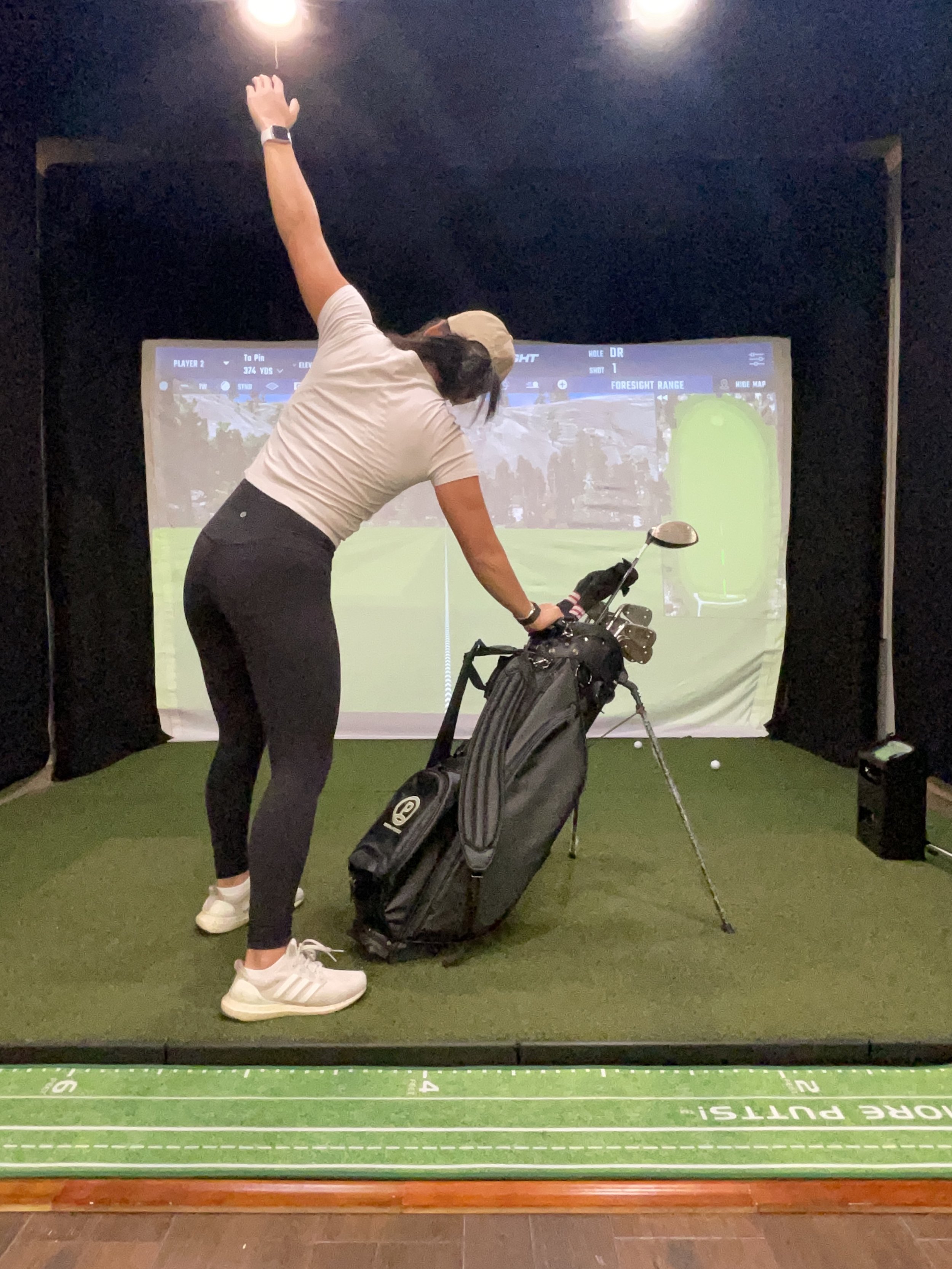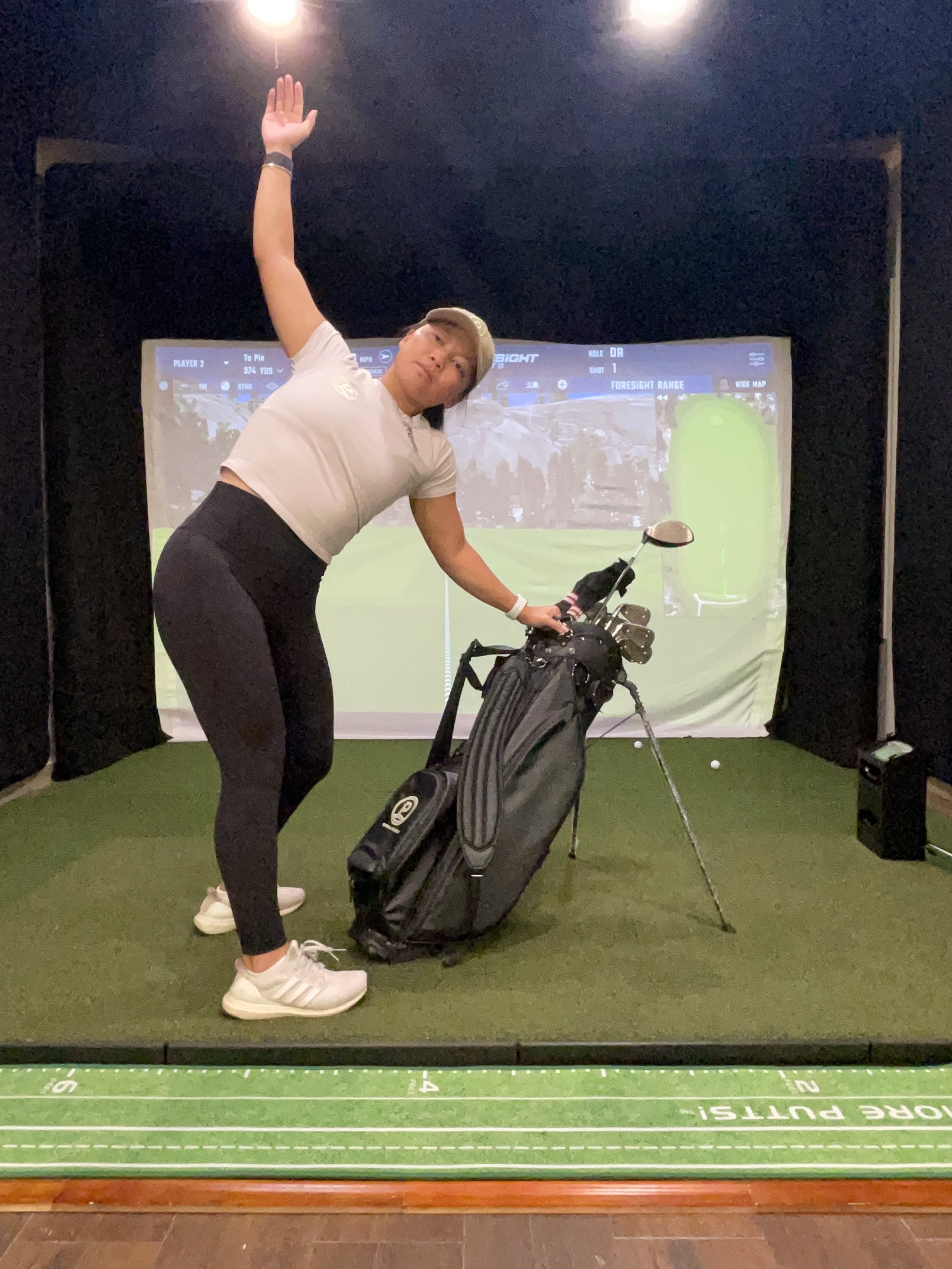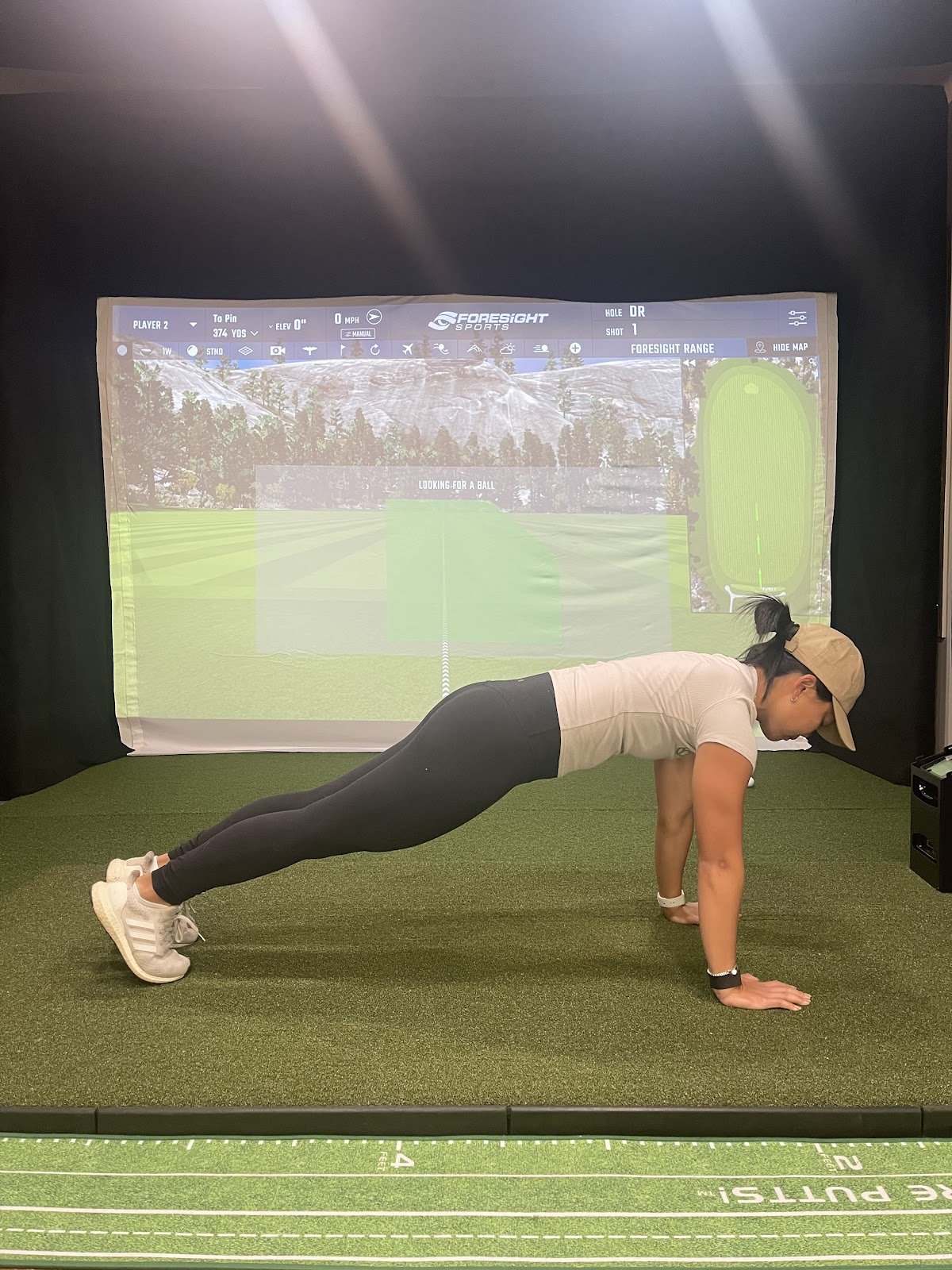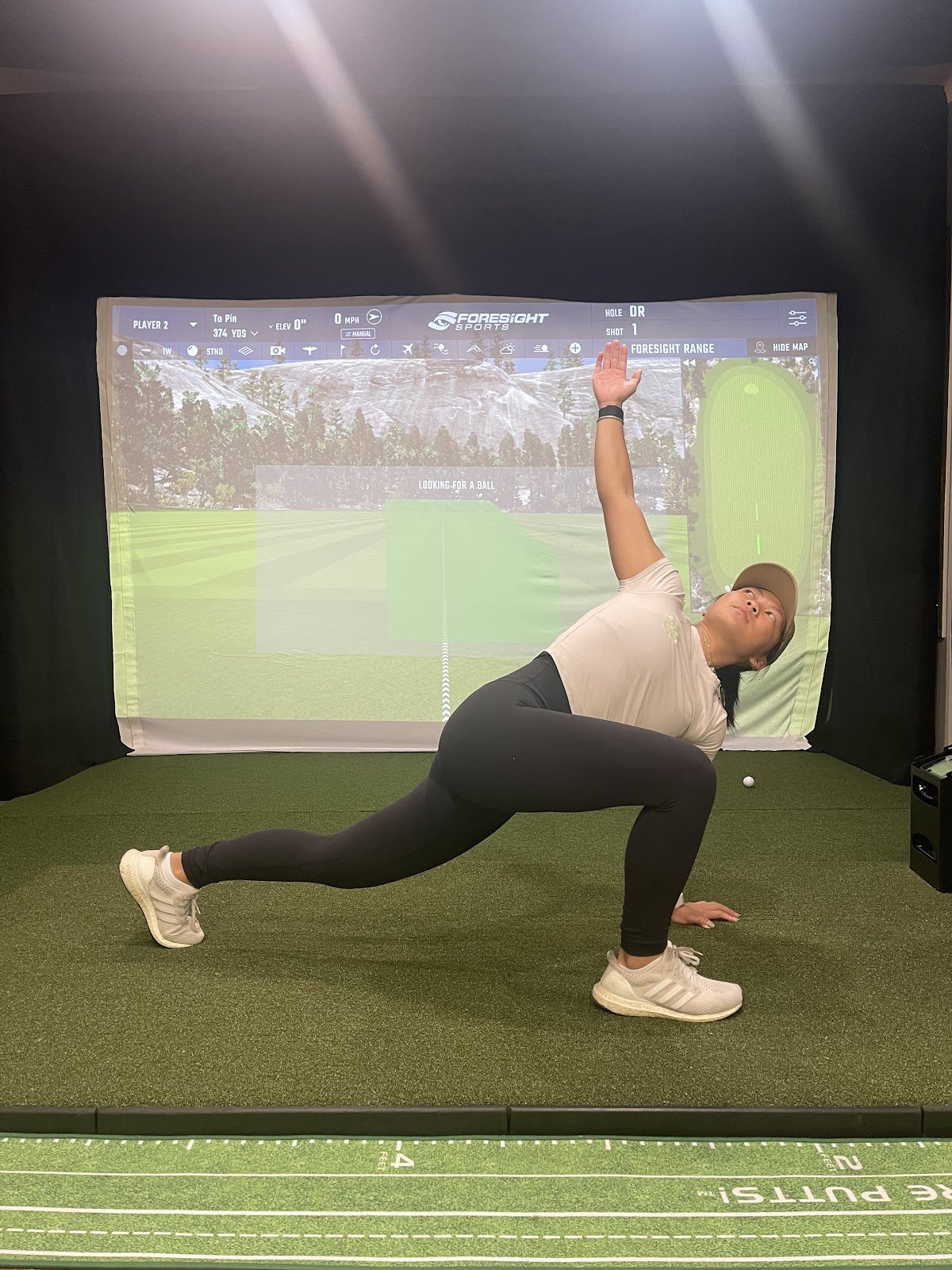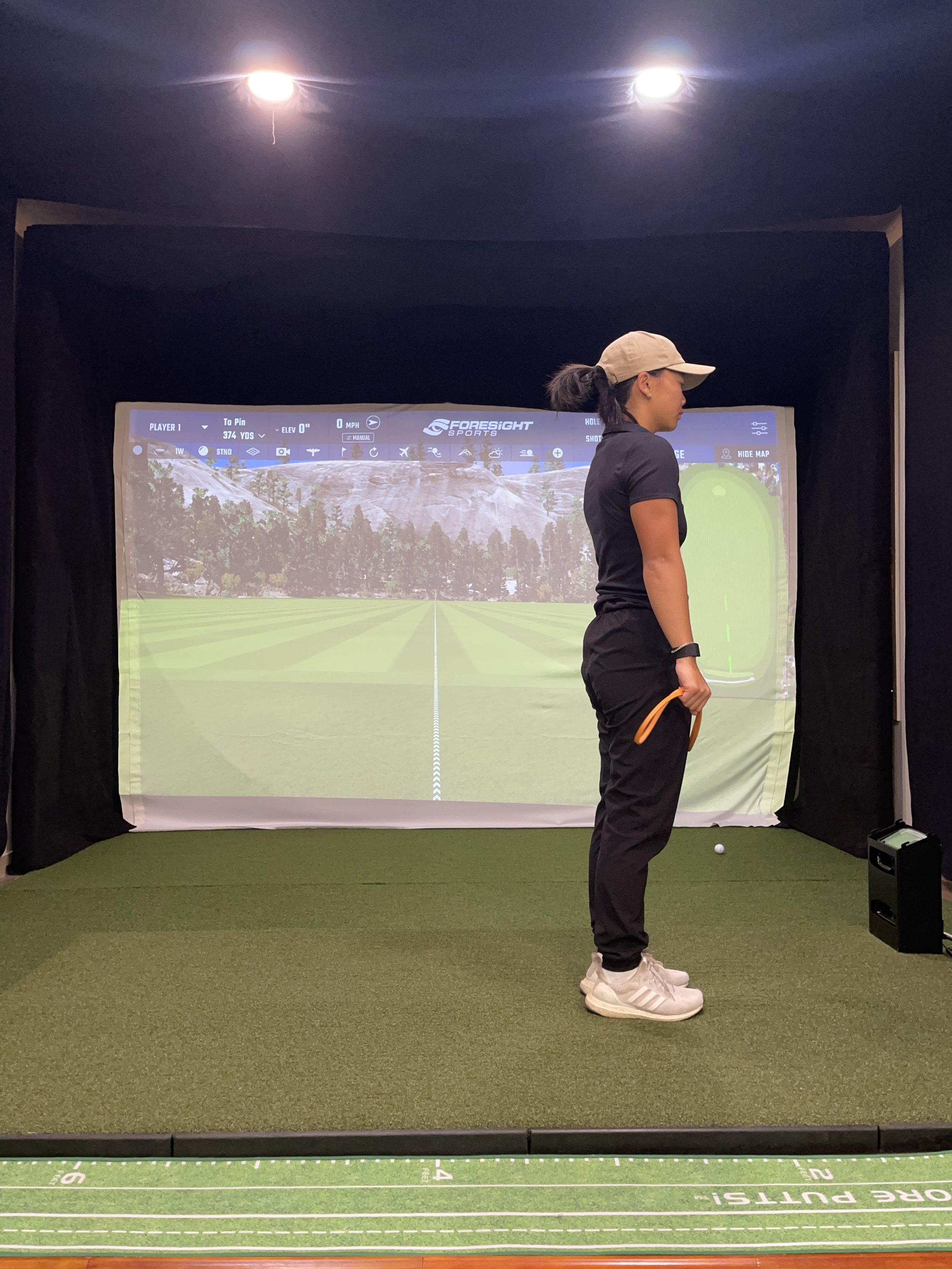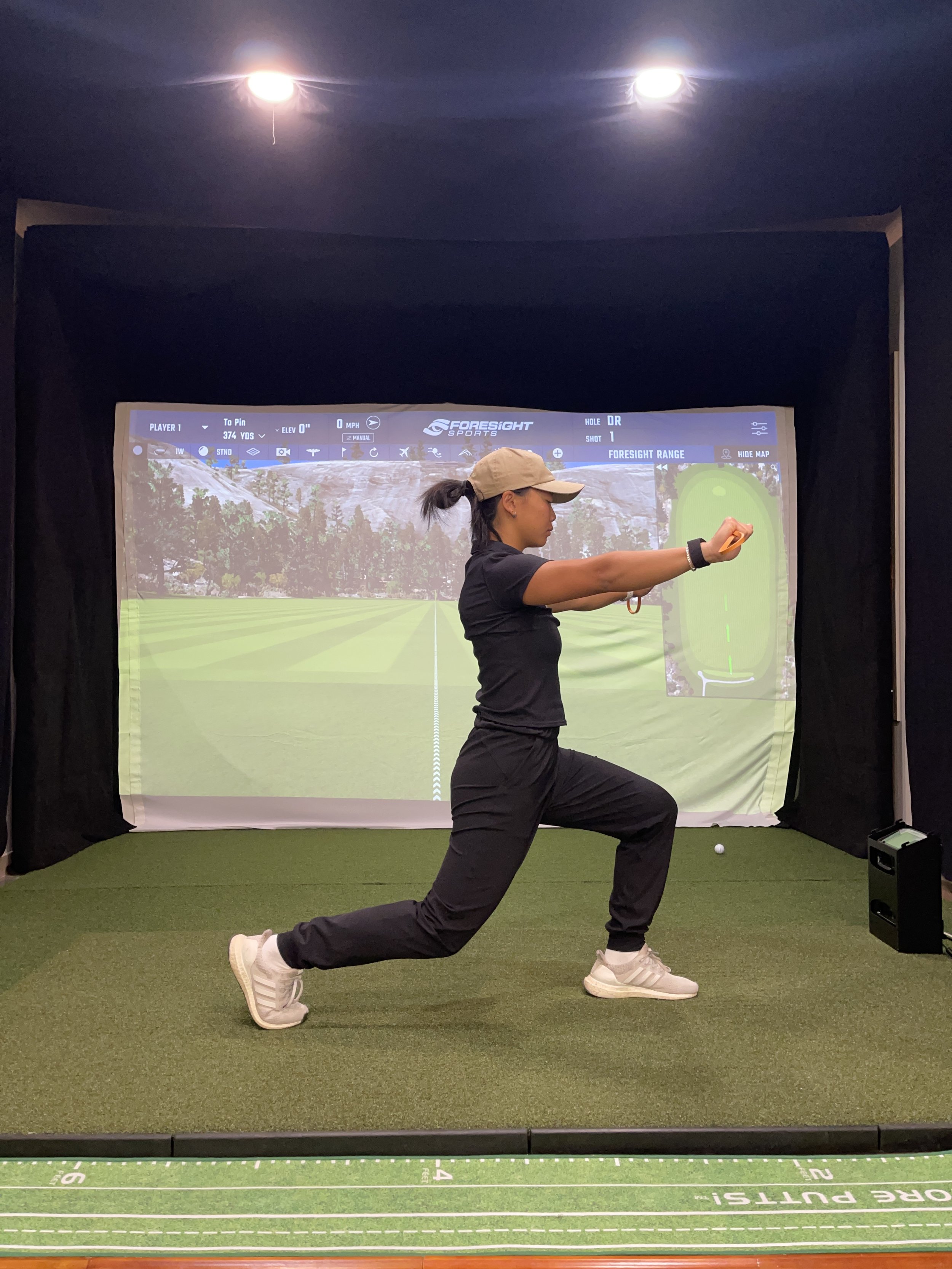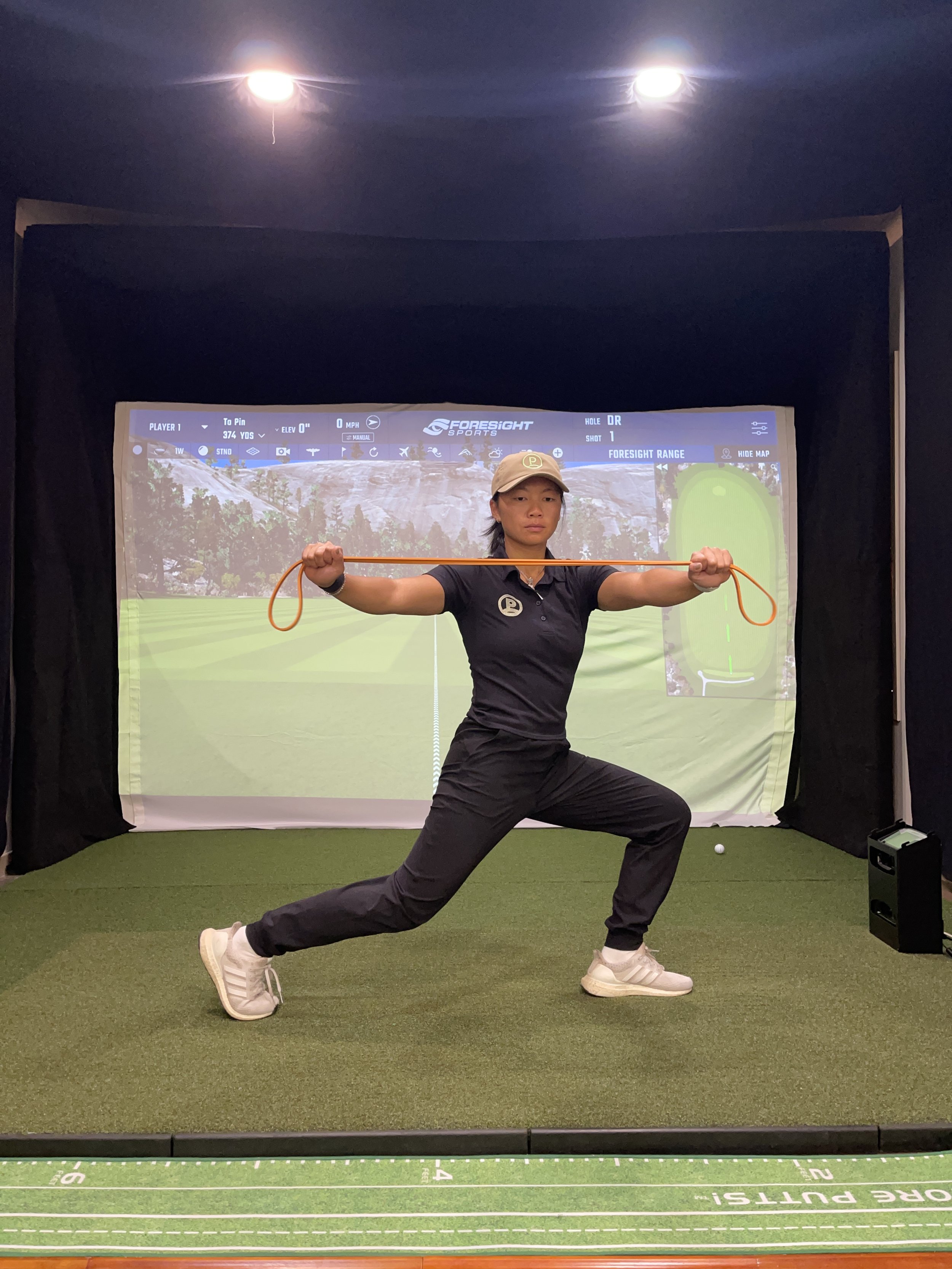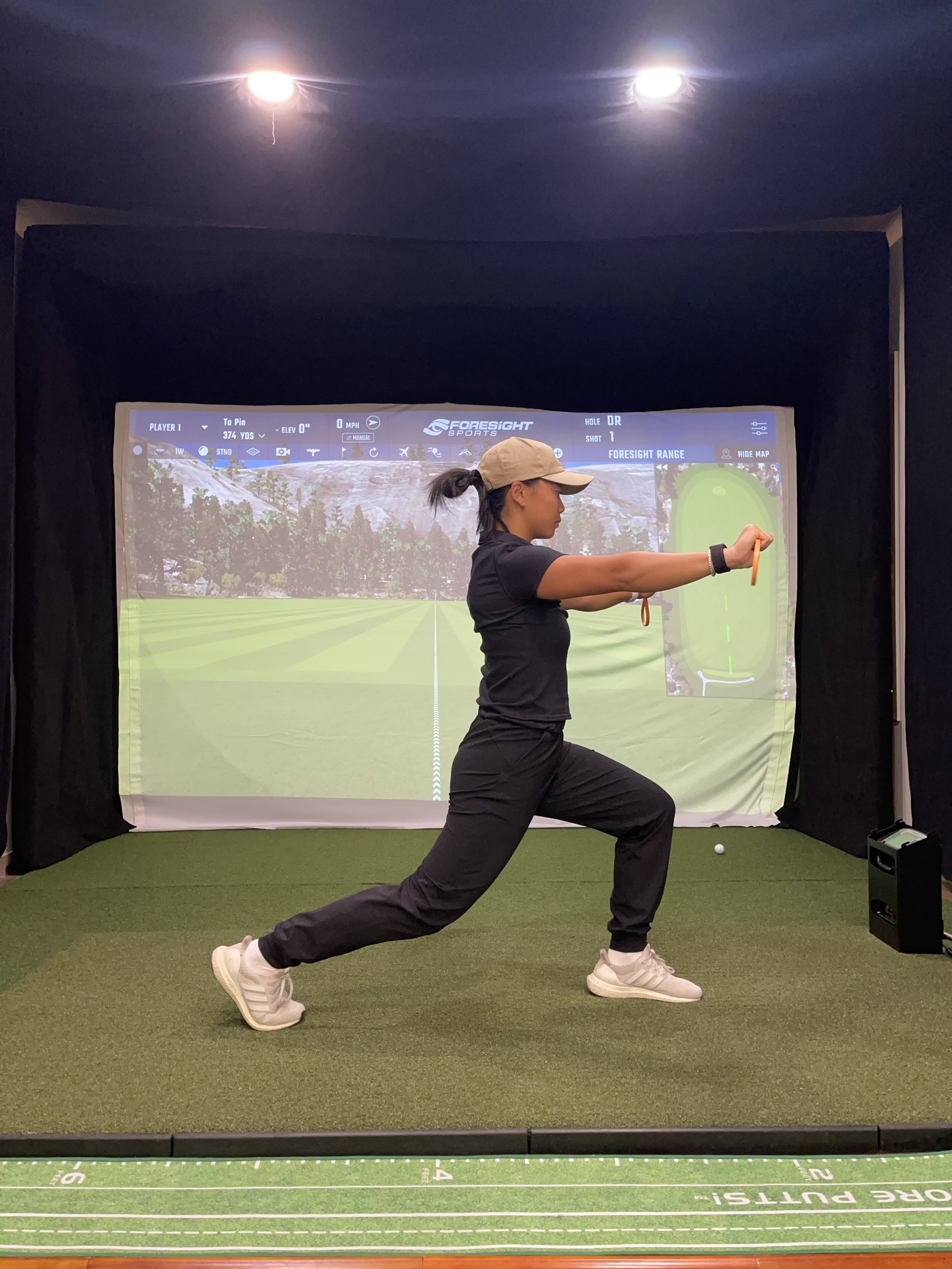Golf Warm-Up Routine
Golf is both a sport and an endeavor demanding physical and mental effort. Just as you wouldn't anticipate a quarterback entering a game without warming up, performing effectively, and avoiding injury, the same principle applies to golf. Suppose you have yet to prepare adequately before stepping onto the first tee. Achieving peak performance becomes challenging.
Table Of Contents
Thread the Needle on the Ground and/or Golf Bag
How to Perform on the Ground
How to Perform on the Golf Bag
World's Greatest Stretch
Forward/Reverse Lunge Twist with a Golf Club or Resistance Band
Resistance Band Warm-Up for Shoulders
Band Pull Aparts
Band Shoulder Dislocations
Overhead Pull Apart
Benefits of Warming Up
Importance for Golfers
Specific Benefits for Shoulders
Exercise Cautions
Avoiding Overdoing Warm-Ups
Duration of Warm-Up Routine
Post-Round Cool-Down
Essential Steps for Recovery
Hydration and Nutrition
Hot Bath or Shower
Gentle Yoga or Stretching
Foam Rolling
Deep Breathing or Meditation
How Important Is Warming Up Before Playing Golf?
Your golf warm-up can be simple enough. The goal is to elevate your heart rate and promote blood flow, all while simulating the movements you'll make on the course. Focus on key areas like your spine, arms, hips, and legs. You'll be engaging in rotational movements that generate torque from your spine and hips, so your arms must maintain stability throughout the swing. Your legs need to provide a strong and steady foundation for solid contact with each stroke.
Before You Start Your Round of Golf, Take a Few Minutes to Move with Intention.
Thread the Needle on the Ground and/or Golf Bag
The "thread the needle" stretch is a yoga pose that can help improve flexibility and relieve shoulder and upper back tension. Here's how to do it:
On the Ground:
Start in a tabletop position on your hands and knees, with your wrists directly under your shoulders and your knees under your hips.
Inhale as you reach your right arm up toward the ceiling, opening your chest and twisting your upper body to the right. Your gaze can follow your hand.
Exhale and thread your right arm under your left arm, bringing your right shoulder and cheek to the mat. Your left-hand remains on the ground, supporting your weight. Your hips should remain elevated.
Hold the stretch for 10-15 seconds, feeling a gentle stretch in your right shoulder and upper back. Breathe deeply and relax into the pose.
To release, inhale and reach your right arm back up to the ceiling, then return it to the starting position.
Repeat the stretch on the other side by raising your left arm, twisting to the left, and threading it under your right arm.
Repeat 7-10 times on each side.
Threading the needle is a great way to release shoulder tension and improve upper-body mobility. Be sure to perform it on both sides to maintain balance and flexibility.
2. On the Golf Bag:
Threading the needle is different compared to on the ground. Instead of just the upper back, you will be mobilizing your hips.
Start by being in a golf position with one hand on top of the golf bag
Inhale as you reach your right arm up toward the sky, opening your chest and twisting your upper body to the right. Your gaze can follow your hand. However, you want to have your hips rotating to the right.
Exhale and thread your right arm under your left arm, bringing your right shoulder towards the bag and rotating your hips to the left.
Hold the stretch for 10-15 seconds, feeling a gentle stretch in your right shoulder, upper back, and hip. Breathe deeply and relax into the pose.
To release, inhale and reach your right arm back up to the sky and, rotate your body, then return it to the starting position.
Repeat the stretch on the other side by raising your left arm, twisting to the left, rotating to the left, and threading it under your right arm.
Threading the needle on the golf bag is an excellent option to release shoulder tension and improve mobility in the upper body and hips. Be sure to perform it on both sides to maintain balance and flexibility.
3. World's Greatest Stretch
Starting Position:
Begin in a standing position.
Into the Stretch:
Take a large step forward to get into a lunge position.
Place both hands on the ground inside your front foot. This will effectively lengthen the back leg and create a stretch in the groin of the forward leg, explicitly targeting the adductors.
Rotate and Extend:
Lift the arm on the same side as your forward foot upward, reaching toward the ceiling. This action involves a rotation of your upper body and spine. Simultaneously, it will stretch your hamstrings.
Maintain a straight and active back leg while you perform the rotation.
Returning:
Lower the raised arm back to its initial position.
Push back to a standing position.
Alternate and repeat the entire sequence with the other leg and repeat on each side 5-7 times.
4. Forward/Reverse Lunge Twist with a Golf Club or Resistance Band
Forward/Reverse Lunge Twist warms up golfers, activating the core and lower body to help your mobility, stability, and strength.
Setup:
Begin by standing with your feet hip-width apart
Hold a golf club or resistance band in both hands, with your hands shoulder-width apart
Forward Lunge with Twist:
Take a step forward into a lunge position. The front knee should be 90 degrees, and your back knee should hover above ground.
After making your lunge, twist your torso to the side of your forward leg with your arms fully in front of you while holding the resistance band.
Reverse Lunge with Twist:
Complete the forward lunge.
Return your front foot to the starting position.
Step backward into a reverse lunge using the same leg you lunged forward with.
Ensure your trailing leg hovers just above the ground.
As you move into the reverse lunge:
Twist your upper body in the opposite direction of your stepping leg.
Extend your arms straight in front of you.
Hold onto the resistance band, keeping it taut.
Number of Reps:
Perform a set number of reps to complete one set. A good number is 7-10 lunges on each side.
Tips:
Keep your core engaged throughout the exercise to maintain balance and stability.
Be mindful of your knee alignment, ensuring they do not extend past your toes during lunges.
Warm up with light cardiovascular exercise before starting this lunge twist to increase blood flow and body temperature.
Benefits:
Activation of Core and lower body muscles
Twisting motion engages and strengthens your core muscles, which are essential for stability and power in your golf swing.
Improved mobility
Enhances your hip mobility and flexibility for a smoother and more efficient golf swing
Increased stability
Incorporating lunges will improve your lower body stability and help maintain a strong, balanced stance during your golf swing.
Dynamic warm-up
It serves as an effective warm-up routine to help prepare your body for the demands of a round of golf.
Resistance Band Warm-Up For Shoulders
Resistance Band, Warm Up for Shoulders, will improve shoulder mobility and stability, alleviating shoulder pain by enhancing your range of motion and promoting proper rotation in your golf swing.
Warm-Up Routine:
Band Pull Aparts
Hold the resistance band with both hands, keeping your palms facing down and hands shoulder-width apart.
Stand with your feet shoulder-width apart and your arms extended in front of you.
Begin by pulling the band apart laterally, stretching it across your chest.
Return to the starting position by bringing your hands back together in front of you.
Perform 10-15 repetitions.
2. Band Shoulder Dislocations
Hold the resistance band with both hands; arms extended wide apart.
Gently raise the band over your head and behind your back, aiming to touch your lower back with the band.
Carefully bring the band back over your head to the front.
Perform 10-12 repetitions, gradually increasing your range of motion as you go.
3. Overhead Pull Apart
How resistance band with both hands, keeping your hands wider than shoulder-width apart
Slowly lift your arms overhead while maintaining proper posture with shoulders down and back.
Pull the resistance band apart by moving both arms out to the sides.
Perform 10-15 repetitions.
Benefits of Warming Up The Shoulders
Improved Shoulder Mobility: These exercises target various shoulder movements, helping to enhance your range of motion.
Increased Stability: Strengthening the muscles around the shoulder joint promotes better stability and reduces the risk of injury.
Enhanced Rotational Mobility: This warm-up is particularly useful for golfers, as it helps prepare the shoulders for the rotation required in the golf swing.
Pain Relief: For those with shoulder pain, these exercises may provide relief by promoting blood flow and reducing muscle tension.
Exercise Thoughtfully - Overdoing Warm-Up Can Lead to Injuries.
The warm-up we just finished should be concise, typically lasting 7-10 minutes. There's no necessity to push yourself to the limit or engage in numerous repetitions before you begin your round. Redundant and unnecessary movements can harm your performance and increase the risk of injuries.
Post-Round Cool-Down
An effective post-round cool-down is essential to facilitate recovery and prevent injuries following a game of golf. I will elaborate on your initial recommendations and introduce additional insights.
Upon completing a demanding round of golf, emphasizing body recovery and relaxation is paramount. A structured cool-down regimen serves the dual purpose of minimizing soreness and reducing the risk of injuries while fostering overall muscle health.
Evaluate and Document:
Take a moment to reflect on your game performance. Record any instances of discomfort or tightness you experienced. These insights can guide adjustments in your future warm-up and training sessions, allowing you to customize your fitness routine for improved game performance and recovery.
Hydration and Nutrition:
Rehydrate with water or sports drinks to restore lost electrolytes. Adequate hydration is essential for muscle function and recovery.
Also, consider consuming a well-balanced snack or meal abundant in proteins and carbohydrates to expedite muscle recovery and replenish glycogen stores.
Hot Bath or Shower:
Indulging in a warm bath or hot shower can alleviate tense muscles and enhance blood circulation. Consider adding Epsom salts to your bath; they can relieve muscle soreness and create a calming effect.
Gentle Yoga or Stretching:
Include straightforward yoga poses or stretching exercises that focus on the muscle groups central to the game of golf, such as the back, hips, shoulders, and hamstrings.
Child's Pose: Encourages relaxation in the back and hips.
Cat-Camel Stretch: Promotes spinal flexibility and relaxation.
Downward Dog: Increases flexibility in the hamstrings, calves, and shoulders.
Open Books Stretch: Enhances rotational mobility in the spine and shoulders.
Foam Rolling:
If you have access to one, use a foam roller to address sore muscles, mainly focusing on areas like the lower back, glutes, and legs. This technique of self-myofascial release aids in the breakdown of muscle knots and improves muscle recovery.
Deep Breathing or Meditation:
Allocate a few minutes to engage in deep breathing exercises or meditation. This practice can be highly effective in soothing the mind, alleviating stress, and facilitating relaxation after an extended game.
Remember, the key to a successful golf game doesn't end with the last hole; it's about the care and attention you provide to your body afterward. This ensures you're in the best shape for your next round!
If you're serious about golf, you must train with the best. At our Bay Area golf training locations, we offer a comprehensive approach to improving your game. Our experienced coaches will help you build strength, improve flexibility and stability, and hone your skills.
Our comfortable and supportive environment will help you stay motivated and focused on your goals. Click here to book an assessment today and start playing better golf tomorrow!







